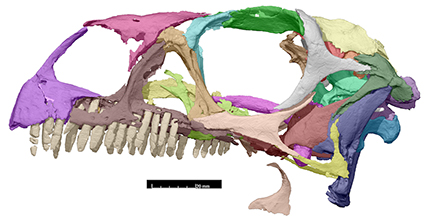Chapelle, who is studying at the Evolutionary Studies Institute at the University of the Witwatersrand, used the university’s Wits MicroFocus CT Facility to digitally rebuild every bone of Massospondylus‘ cranium and even to examine tiny features like nerves exiting the brain and the balance organs of the inner ear. She was surprised to realize that, considering Massospondylus‘ fame, the dinosaur’s skull had never been the subject of any in-depth examination before.
“I was amazed when I started digitally reconstructing Massospondylus’ skull, and found all these features that had never been described,” said Chapelle. “It just goes to show that researchers still have a lot to learn about South Africa’s dinosaurs.”
Among Chapelle’s discoveries were details about what the inner ear and middle ear looked like and how they contacted each other, as well as where the nerves connecting different parts of the skull to the brain were and which bones they went through. She learned that replacement teeth don’t erupt in a specific pattern and that they are present on all teeth, and that the bones surrounding the brain in this particular fossil were not fully fused, meaning that the dinosaur was not full grown.
Chapelle’s research is published in a paper entitled “A revised cranial description of Massospondylus carinatus Owen (Dinosauria: Sauropodomorpha) based on computed tomographic scans and a review of cranial characters for basal Sauropodomorpha,” which you can read here. Along with the paper, Chapelle has made the 3D printable file of the skull available on MorphoSource, where many fossils can be found for 3D printing.“By comparing the inner ear to that of other dinosaurs, we can try and interpret things like how they held their heads and how they moved,” said Chapelle. “You can actually see tiny replacement teeth in the bones of the jaws, showing us that Massospondylus continuously replaced its teeth, like crocodiles do, but unlike humans that can only do it once. Also, the fact that the bones of the braincase aren’t fully fused means that this particular fossil is that of an individual that is not fully grown yet. This allows us to understand how Massospondylus grew, how fast it grew and how big it could grow.”
“This means any researcher or member of the public can print their own Massospondylus skull at home,” she said.
3D printing and 3D scanning have revealed great quantities of information about the creatures that have left their fossils behind for millions of years. Hundreds of Massospodylus fossils have been found in South Africa, and Chapelle plans to continue to research the dinosaur using scans of these additional fossils.

“I’ll be using scans of other specimens to answer new questions,” said Chapelle, “for example, how did Massospondylus babies weighing less than 100g grow up to be half-tonne adults?”
There are many questions that fossils have left for millenia, and for the first time, they can be answered, thanks to 3D technology.
“Students like Kimi have been able to use our CT facility to produce cutting-edge research like this, and it’s changing the way we do dinosaur research,” said Professor Jonah Choiniere, the supervisor and co-author of the study.
Discuss this and other 3D printing topics at 3DPrintBoard.com or share your thoughts below.
[Source/Images: University of the Witwatersrand]

